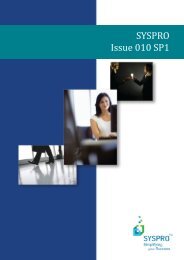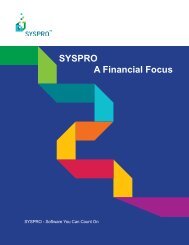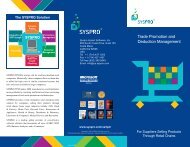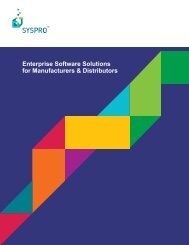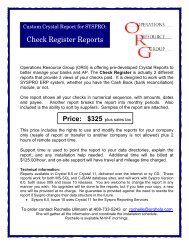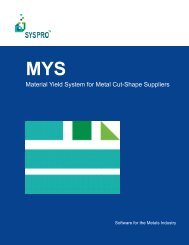Teach Yourself e.net - Syspro
Teach Yourself e.net - Syspro
Teach Yourself e.net - Syspro
Create successful ePaper yourself
Turn your PDF publications into a flip-book with our unique Google optimized e-Paper software.
Defining e.<strong>net</strong> solutions<br />
2.6.1.2. Major Components of .NET<br />
At the core of The .NET Framework is a component called the Common Language<br />
Runtime (CLR). The CLR can be thought of as a separate operating system that runs<br />
within the context of another operating system (such as Windows XP or Windows 2000).<br />
This idea is not something new. We have seen this with the Java Virtual Machine, as well<br />
as the environments of many interpreted languages such as BASIC and LISP which have<br />
been around for decades. The purpose of a middleware platform like the CLR is simply<br />
that a common OS like Windows is often too close to the hardware of a machine to retain<br />
the flexibility or agility required by software targeted for business on the Inter<strong>net</strong>.<br />
Software running on the CLR (referred to as Managed Code) has the needed flexibility and<br />
is exceptionally agile.<br />
Unlike interpreted languages, managed code runs in the native machine language of the<br />
system on which it is launched. In short, this is how the .NET process works:<br />
1. Developers write their code in a .NET enabled language.<br />
2. The compiler generates binary executable software in a p-code format called Common<br />
Intermediate Language (or CIL for short).<br />
3. When the software is launched, the CLR re-compiles or JIT-compiles (Just In Time) the<br />
CIL into native code such as x86 machine language.<br />
4. Then the code is then executed at full speed.<br />
Another component of the .NET Framework is the massive library of reusable object-types<br />
called the Framework Class Library or FCL. The FCL contains hundreds of classes that<br />
perform tasks ranging from file reads and writes to advanced cryptography and web<br />
services.<br />
The CLR is intrinsically object-oriented; even its CIL (the p-code, which can be viewed as<br />
a virtual assembly language) has instructions to manipulate objects directly. The<br />
Framework Class Library reflects the platform's object-oriented nature. For most<br />
programmers, the FCL is the most extensive and extendable class library that they will<br />
have ever worked with.<br />
Finally, the .NET Framework contains a collection of tools and compilers that help to<br />
make programming productive and enjoyable. Up until now we have not mentioned much<br />
about C# (pronounced See-Sharp) or Visual Basic.NET (we'll be programming in these<br />
languages later). The reason is that the real core of .NET is the CLR. However, over<br />
twenty language compilers are currently being used in the .NET Framework, including the<br />
original five .NET languages from Microsoft: Visual Basic, C#, C++, JavaScript and CIL.<br />
The CLR and the .NET Framework have been designed in such a way that code written in<br />
one language can not only seamlessly be used with another language, but it can also be<br />
naturally extended by code written in another programming language. This means that<br />
2–11



